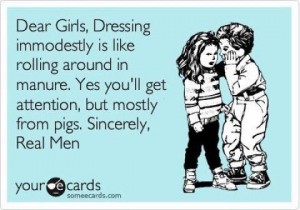With the US Supreme Court overturning Roe v. Wade, leaving the question of abortion up to individual states, many American Mormons are celebrating the chance they have to live in a state that bans all (or nearly all) abortions. The Church’s official position allows for abortion under some circumstances, which makes it not consistent with such blanket bans. So why the inconsistency? Why, when the official position allows for some exceptions, are so many Church members excited to have all abortions banned?
A few years ago, I wrote a post where I asked this question and suggested an answer based on reviewing a bunch of Church rhetoric around abortion. I concluded that while GAs wrote the exceptions, their rhetoric constantly minimizes their occurrence, making them seem so rare as to be negligible.
Today I want to consider another line of explanation in addition: Church rhetoric on other issues—I’m taking modesty as an example—is based on a deeply patriarchal worldview that is straightforward to apply to abortion too. Note, just to be clear, that I’m not arguing that the Church’s stance on modesty causes its (or its members’) stance on abortion. I’m just saying that they’re both driven by the same underlying stance on women, so when GAs talk about one issue, it’s easy for members to understand the worldview and generalize it to another issue.

Here are some points of similarity I’m thinking of:
Men’s responsibility is ignored.
In Church modesty rhetoric, there is lots of discussion of women (and girls) needing to dress a particular way to avoid giving men (and boys) sexual thoughts or ideas about their sexual availability. There is no discussion of the need for men to stop themselves from objectifying women, regardless of how they’re dressed. (This is in contrast, of course, to Jesus’s famous admonition that “if thy right eye offend thee, pluck it out . . .”)
It’s easy to see how this line of thinking lines up with abortion too. Nearly all pregnancies result from an act of sexual intercourse between a man and a woman, but anti-abortion rhetoric focuses pretty much completely on women. Sex is something that just happens, and so is pregnancy. Men’s participation is ignored. It’s assumed that if women don’t want to be pregnant, it’s on them to prevent it from happening. The whole topic of abortion isn’t even brought up until there’s a pregnancy.
The same line of thinking plays out in the Church too. Men are never reminded not to pressure their partners into unwanted sex or into unwanted pregnancy. In fact, given that couples are told to work out their childbearing decisions between themselves and God, but husbands are also told they’re to preside over their families, it seems likely that the effect in many families is that husbands dictate to wives how many children they will be bearing. Also, needless to say given that even these topics aren’t discussed, men are certainly never told explicitly not to commit rape.
